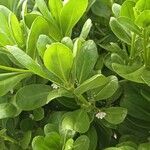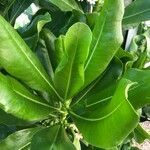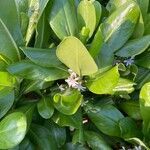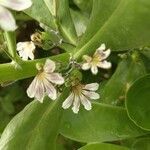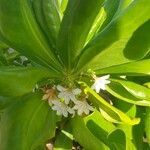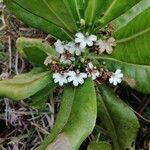A much-branched evergreen shrub or small tree, glabrous and succulent, with the leaves clustered at the branch-tips and leaving leaf-scars below.. Stem yellowish greenish.. Leaf-axils without or with sparse silky hairs; leaves sessile or petiolate (the petiole winged), obovate, 5–11 cm. long, 2–7 cm. broad, entire, obtuse, narrowed strongly from the widest part towards the base, thickly fleshy, yellowish green; lateral veins obscure, 2–4 pairs, the lower long and narrowly diverging from the midrib.. Inflorescence a series of axillary cymes bearing conspicuous glabrous bracts (which may have hairs in their axils) and 1–7 sessile flowers.. Calyx-limb short, scarcely divided, 2 mm. long.. Corolla white or greenish; tube 10–12 mm. long, 3 mm. broad, crowded with hairs inside and shortly pubescent outside; lobes 6–10 mm. long, with a greenish, thick central part, and white, thin, crenulate marginal part.. Ovary 2-locular, 1 ovule only developing.. Fruit blue or black, sub-globose, 10–15 mm. across, very fleshy, drying warty.. Seeds single, not dispersed from the fruit.. Fig. 1/10–12.
Much-branched, low, spreading, evergreen shrub, up to 3 m high. Leaves clustered at branch tips, simple, sessile or shortly petiolate (petioles winged), obovate, up to 110 mm long, entire, base tapered, glabrous, thickly fleshy. Inflorescence a series of short, axillary cymes; bracts linear, up to 15 mm long; flowers 1-7, sessile. Flowering time Oct.-Jan. Calyx campanulate, ± 2 mm long, shortly 5-lobed. Corolla irregular, up to 23 mm long, white or ± green outside, ± yellow inside, 5-lobed, margins crenulate, tube split down to base. Fruit a subglobose drupe, blue-black, 10-15 mm in diam., glabrous, fleshy, drying wrinkled. Seed discoid, not dispersed from fruit.
Leaves in dense terminal clusters, very succulent, 5–9(11·5) cm. long, 2–5(7·5) cm. broad, obovate and tapering towards the base, sessile or shortly petiolate, with the apex rounded, entire, glabrous, yellow–green; lateral veins rather obscure (better visible in dried leaves).
A small shrub. It grows up to 50 cm high. It is branched and leans over. The branches are thick and succulent. The leaves are 2-8 cm long by 8-35 mm wide. They taper to the base. The leaf scars are prominent. The fruit is fleshy and purple. It is edible but acrid.
Corolla white or greenish, often yellowish inside, up to 23 mm. long; tube 9–13 mm. long, up to 3 mm. wide, pubescent outside, villous inside; lobes up to 11 mm. long, with a succulent green centre and whitish membranous crenulate margins.
Sprawling perennial to 40 cm. Leaves fleshy, obovate. Flowers sessile in axillary cymes, whitish, tube slit above and woolly within.
Ovary bilocular, with only one ovule developing (always?); style pubescent, with the apical indusium finely ciliate.
Flowers sessile, arranged in short bracteate axillary cymes; bracts linear, glabrous or with hairs in the axils.
Fruit black or bluish, ellipsoid to globose, 10–15 mm. wide, rather fleshy, wrinkled when dry.
Evergreen small tree or shrub, 30–90(150) cm. tall, succulent, almost glabrous.
Stems greenish or yellowish, covered with prominent oblique leaf–scars.
Calyx very short, 1·75–2·5 mm. long, lobes hardly discernible.
A low shrub 1-3 ft. high, succulent and nearly glabrous
Flowers white or greenish-yellow, fruits blue-black
Seeds single, contained within the fruit.
Thick branchlets marked by leaf-scars
Petiole winged.
